Tips For Feeding The Birds In Winter - And How Bees Help
We are coming toward the end of October. The weather is getting cooler, and it's this time of year when we start to think of stocking up food for the birds (naturally, at our house we love wildlife generally).
I could be wrong, but I've been predicting snow for some time. It was merely intuition, then later, seeing a more abundant crop of berries on the trees and bushes than usual. I kind of believe the plants and trees know something we don't!
Anyway, weather forecasters are now predicting snow too, so maybe I should get into the weather-forecasting business!
Winter berries
Most people know that bees pollinate the flowers of trees and shrubs that later provide berries, nuts, seeds and hips for birds and mammals of all kinds.
The flowers of cotoneaster, holly, roses, guelder rose, hawthorn and many, many more, all benefit from pollination by bees and other pollinators. The fruits they produce are in turn, enjoyed by wildlife, which then returns the compliment by scattering the seeds in their poop (a natural dollop of fertilizer!).
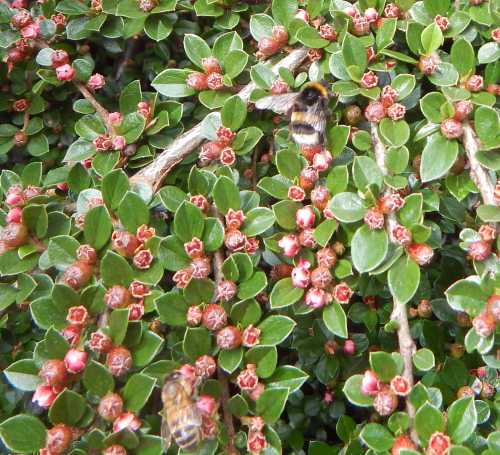 Bees foraging on cotoneaster flowers.
Bees foraging on cotoneaster flowers.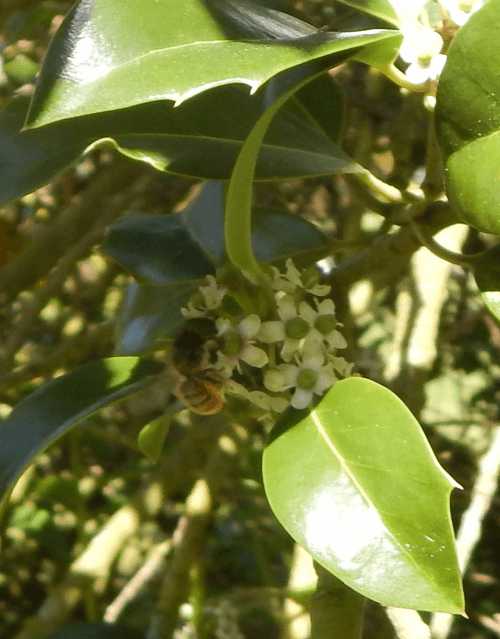 Mason bee on holly flowers.
Mason bee on holly flowers.
In our garden, we have cotoneaster berries, ivy and a young pyracantha. A small variegated holly doesn't yet produce much in the way of berries. We have red currants too, but they are snaffled by the birds by the end of August.
Anyway, from past experience, we know that once the snow comes, the berries in our garden are devoured in next to no time, so we like to provide a little extra help.
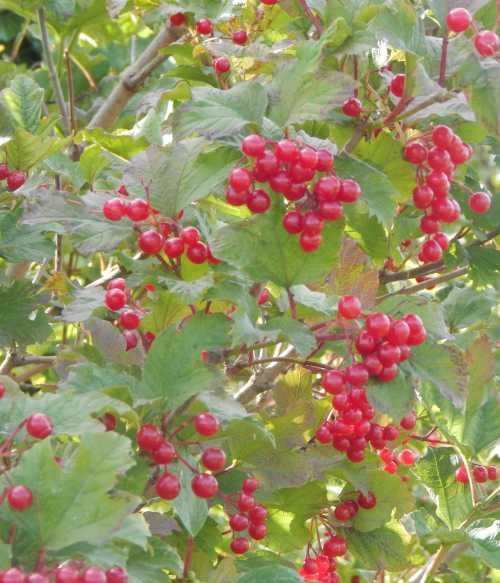 Guelder rose berries - a favourite with hungry birds in winter.
Guelder rose berries - a favourite with hungry birds in winter.In the past we used to stock up with fat balls and lots of seeds (sunflower and mixed) to give the birds a little extra help.
We do things a little differently now, thanks to observing nature - and help from pollinators! I thought I would share with you some of our activities.
Feeding the birds in winter
Here are some of the things we do to provide food for birds over the cold period.
Leftover raspberries
Thanks to pollination by bees and wasps, we have an abundant crop of raspberries every year. We have 2 varieties growing so that we have fruit from June, a slight gap from the end of July, and more fruit again in the autumn. However, toward the end of the season, we have tended to leave the raspberries for the birds.
Except that we noticed they were not eaten (unlike the summer ripening raspberries, which we usually end up sharing with the blackbirds). Not only that, we notice that around this time of year, we get fewer birds in the garden anyway.
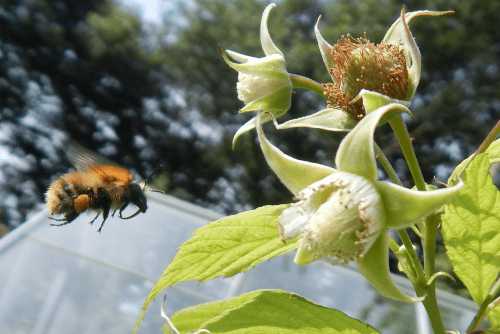 Common carder bumble bee flying toward raspberry flower.
Common carder bumble bee flying toward raspberry flower.
My theory is that the birds are stocking up on other things in order to build up fat reserves: perhaps waxy berries that are ready immediately, and invertebrates. Raspberries might then have less value for them.
So what do we do with the raspberries now?
Rather than waste the raspberries, we pick them and put them in the freezer. We actually started doing this last year (I previously tried freezing leftover cotoneaster berries - it didn't work so well - they are best left on the ground).
When the snow falls, we take the raspberries out of the freezer, thaw them, and mix the whole lot - juice and all, with flour and lard to make a fruity pastry, then bake it.
We add the flour and lard for extra fat and carbohydrate for energy. I think this is much better than purchasing ready made pellets, because in this way, I know exactly what's in the birds' food.
I can't give an exact recipe - I make it up as I go along, until I have a pastry. I may add a few seeds or nuts (never anything salty, such as salted nuts). When I remove the mixture from the oven (careful not to overbake) I break up the pieces, then scatter outside for the birds once cooled.
An alternative is to mix melted lard, fruit and bread, broken up into crumbs. Some people don't agree with giving bread, but I think that's hogwash - it's something generations of people have done for years. As long as the bread is fresh and not mouldy, I think it's fine. Fruit and nuts provide additional nutrition.
Other fruits
Thanks to bees pollinating apple and pear blossom, we can enjoy these lovely fruits whether we grow them in our own gardens or not.
In the past, I have tended to eat an apple or pear, then throw the core out for the birds to finish off.
This time I am doing things a little differently. At this time of year, apple and pear cores will be put in the freezer (no need to do anything else with them).
When the snow comes, or we have an especially cold snap, they will be removed from the freezer, thawed and baked a little, then given to the birds.
The cores of any apples and pears we eat during the cold snaps and snowy weather, will of course be thrown out to the birds as and when we eat the fruit.
Seeds and berries
I am actually very cautious about purchasing bird seed these days. The disgraceful scandal of Scott's seeds knowingly selling poisonous bird seed was one of the things that put me off(1).
I also used to purchase
ready made pellets, including ones labelled 'berry', until I realized the
ingredients seemed a bit vague, and for all I knew, there might be food coloring
in them.
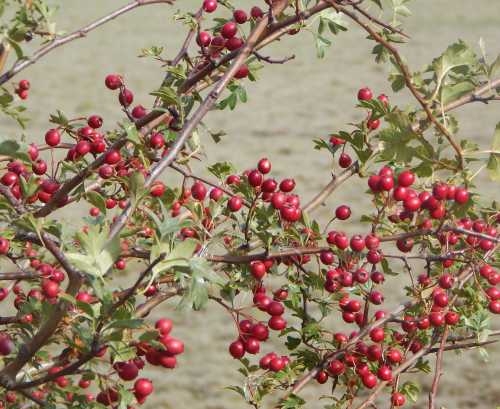 There are plenty of hawthorn berries in the area.
There are plenty of hawthorn berries in the area.As for ready made fat balls, I wonder what is in those too. this is what happens when commercial organisations lose trust - it's so easily lost and so difficult to gain it back.
Fortunately, there are quite a lot of berries and rose hips in the area where I live, and these are helpful for the winter visitors, such as redwings.
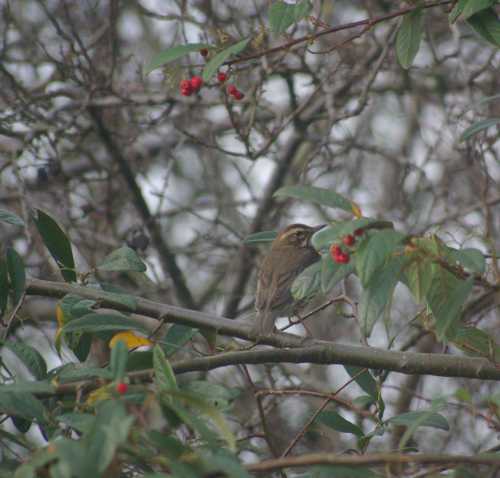 Redwing in our garden - a winter visitor, it feasts on cotoneaster berries.
Redwing in our garden - a winter visitor, it feasts on cotoneaster berries.We may (cautiously) purchase a few bird seeds, but other than that, we leave the seeds naturally available on the flowering plants and shrubs (again, thanks to pollination by bees!).
Plant stalks and stems
Years ago, I used to cut back plant stalks in autumn. I no longer do this. Instead I leave it until early spring before I cut anything back.
I think this has several benefits:
- Birds may eat any leftover seeds in winter, or may eat tiny invertebrates concealed within the dead foliage or stem of the plant.
- The taller stalks help to protect the plant from frost - especially any young growth that might appear.
- Tiny bees and other insects may be overwintering in stems - therefore, even when I cut them back I prefer to leave the stems in a pile at the very back of the garden.
- Covered in snow or frost, I actually think the old stems look beautiful, and they add height to the border, which I prefer over uniform flatness.
Water
We have a pond that will often get iced over, so that birds can't get at the water. A fully iced over pond is also bad news for the frogs.
One great tip is to put a plastic ball into the pond. The following day, pour boiling water over the ball until the ball can be removed. You then have a ready made breathing hole for the frogs, and a place where birds can drink. Be sure to place the ball in a spot that will make it safe and easy for birds to drink.
If you don't have a pond, place a shallow dish of water outside for the birds, and check/replace at intervals - it may well get iced over, and birds need to drink.
Bird tables and feeders?
As a golden rule, I now disagree with the use of bird tables and feeders, although I used to use them in the past. This is how diseases are easily spread from one bird to another via faeces and bacteria accumulating in feeders and on tables.
I have found that contrary to some beliefs, birds are quite adaptable, and birds that may have visited tables and feeders previously (e.g. finches and tit family) are quite happy to pick up food from the ground.
In addition, many films have shown how aggressive birds can be toward one another at tables and feeders, with injury quite possible. For this reason, we scatter food around the garden, and in different places - all spaced out. For height, we put a little on top of the arbour and the garden arch, and some on the plant pot stand.
This year, I'm planning to smear fat mixed with seeds or fruit onto tree branches. I'll see how it goes.
To conclude
Increasingly, I prefer to provide as much food myself as I can, because then I know what the birds are getting.
The garden can provide at least some food - thanks to help from the bees and pollinators. I have found ways to maximise it- especially the raspberries. Of course, depending on where you live (region, country) your circumstances may be different.
I think the best thing to do is observe what happens in your area, and in your garden.
Still, if your scenario is similar to mine, I hope you have found some of these ideas helpful!
References
The scandal of Scott's Miracle-Gro company and the poisoned bird seed - a list of stories from the news from 2012 - 2018 (copy and paste the links in your browser):
1.
Scientific American - 2012: Bird Seed Poisons Wild Birds. To improve shelf
life, Scotts Miracle-Gro used a pesticide toxic to birds in its bird seed.
https://www.scientificamerican.com/podcast/episode/bird-seed-poisons-wild-birds-12-09-16/
2. The Guardian 2012: The Scotts Miracle-Gro company pleads guilty to
knowingly selling poisoned birdseed, and lawn and garden care products
containing undocumented pesticides, to an unsuspecting public.
https://www.theguardian.com/science/grrlscientist/2012/
mar/21/2
3. Dispatch.com Dec 2018: On Friday,
Scotts agreed to settle the suit for $85 million. Scotts does not admit fault
or guilt in the settlement. The settlement offers a full refund to anyone who
bought tainted bird seed.
https://www.dispatch.com/.../scotts-to-pay-85-million-to-settle-poison-bird-seed-lawsuit
Articles about bees and foraging
- Why Do Bees Need Nectar And Pollen? A look at this question from the perspective of different types of bees.
- Plants Toxic For Bees It may surprise readers to learn that some plants produce nectar which is toxic or at least harmful, to bees. Here is a list of plants detrimental to bees, and discussion as to the theories about why plants might produce nectar that would harm potential pollinators.
- Why do bees visit some flowers and not others? Here are 6 reasons Reasons include: Food reward offered, nectar refill rate of the flower, foraging preferences of the bee species, seasonality, and peak nectar production.
If you found this page helpful or interesting, I'd really be grateful if you would share it with others - if not this page, perhaps another, such as Gardening For Bees.
Thank you so much :) .